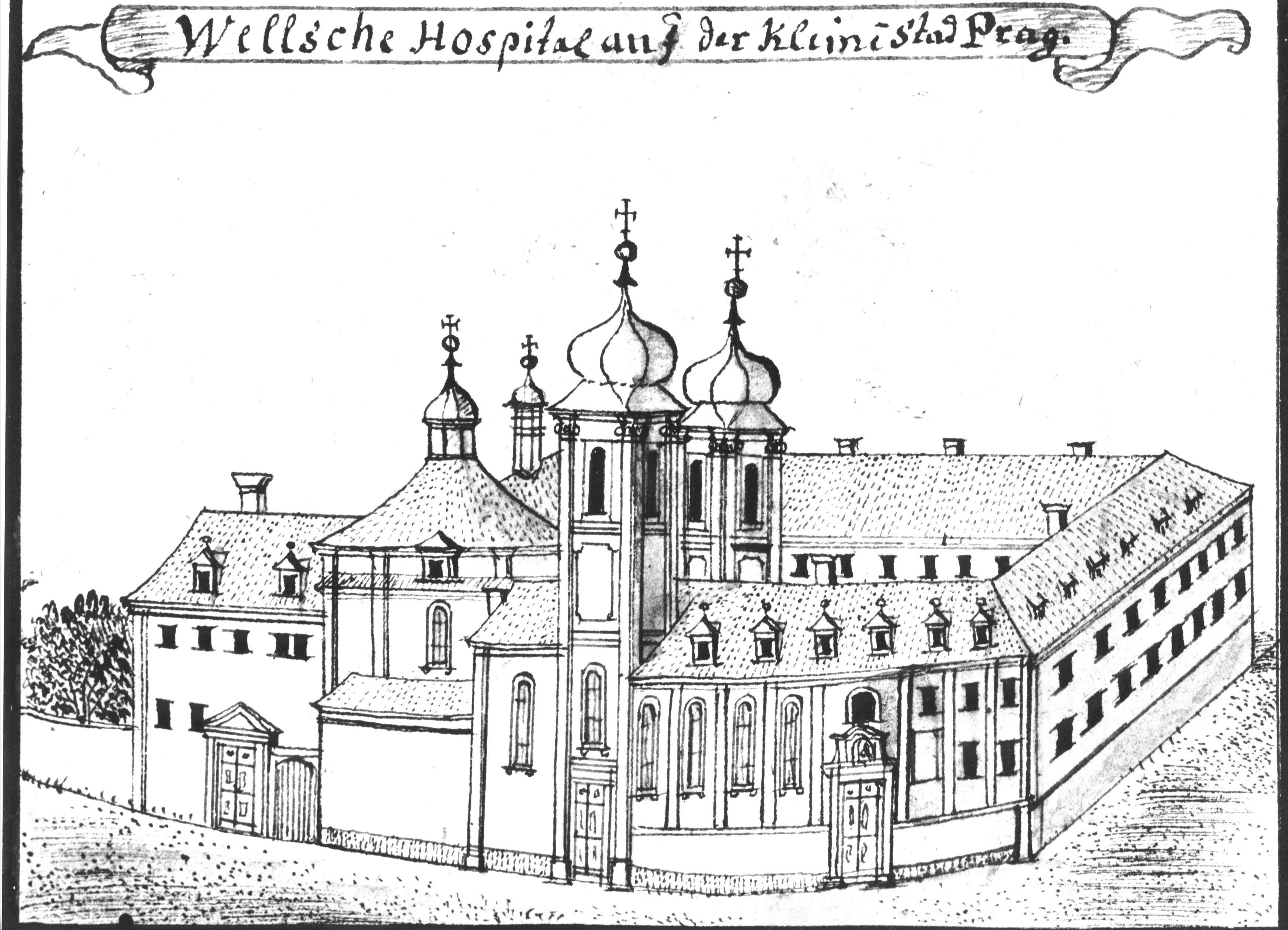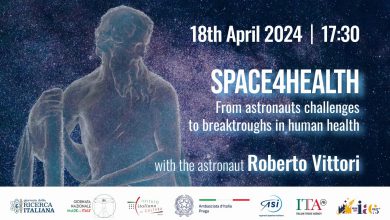
The Italian presence on Czech Republic territory, boasts a long lasting and important tradition. Though the number of Italians present in Prague in the Middle Ages may not have been so high as to speak of a real migration towards the territories of the Czech crown, in the second half of the Sixteenth century, however, in the town of Rudolph II (capital of the Empire since 1583), there was already a large Italian colony, made up construction workers and merchants, who had settled there with their families.
 The Italian merchants were primarily involved in luxury- goods trade, which was in high demand at the time of the imperial court, but the largest group of the colony consisted of architects, masons and plasterers, who were employed in the numerous yards of the Royal Palace and residences of the Czech nobility, attracted by the Renaissance style. The Italian settlers in the capital, came mainly from the region between the Duchy of Milan and the Republic of Venice, and in Prague, they lived close to the castle and along the Vlašská, the “Italian Street”, while their shops surrounded the current Mala Strana square, known at the time as the: “Italian Square”
The Italian merchants were primarily involved in luxury- goods trade, which was in high demand at the time of the imperial court, but the largest group of the colony consisted of architects, masons and plasterers, who were employed in the numerous yards of the Royal Palace and residences of the Czech nobility, attracted by the Renaissance style. The Italian settlers in the capital, came mainly from the region between the Duchy of Milan and the Republic of Venice, and in Prague, they lived close to the castle and along the Vlašská, the “Italian Street”, while their shops surrounded the current Mala Strana square, known at the time as the: “Italian Square”
Over the years, the Italian colony grew to such an extent as to lead the Jesuits of the Collegio Clementino – who had been present in Prague since 1556 – to hold sermons in Italian since 1560, in the church of St. Clement in the area of the Old Town. It was the Jesuits, in fact, who started organising the Italian community and it was under the impetus of the Society of Jesus, between 1573 and 1575 (sources disagree on this) that the community actually created a stable organization with the creation of the Congregation of the Blessed Virgin Mary of the Assumption, an institution with charitable and religious purposes, based on the model of the Marian Congregations of the Jesuit colleges. The purpose of the Congregation was summarized in the motto: “Pro Deo et paupere” and were basically two: to defent the Catholic faith in protestant Bohemia and the creation of charitable works, such as helping the poor and the needy and taking care of the sick, without regard to their religion faith. The first spiritual coadjutor of the new institution was the Italian Father Blasius Montanini.
 In Bohemia, the Italian Congregation was one of the Catholic minorities in the region and that is why it obtained special indulgences from Pope Gregory XIII, in 1580.
In Bohemia, the Italian Congregation was one of the Catholic minorities in the region and that is why it obtained special indulgences from Pope Gregory XIII, in 1580.
In 1569 the Italians had already built their own oratory in the Old City close to the Clementinum and a chapel inside the same area, where religious services used to be celebrated. This chapel was later demolished in 1589 because, by this time, it had become too small and was completely rebuilt since 1590. This new chapel was consecrated in August 1600 by Bishop Filippo Spinelli, Papal Nuncio to Rudolf II and still holds a prominent role in the history of architecture, as it appears to be the first example of a transalpine Italian oval chapel. The chapel, surmounted by a dome, was adorned with a magnificent fresco of the Assumption of the Virgin Mary, by an unknown Italian artist of the time. Although dedicated to the Blessed Virgin Mary of the Assumption, people called the chapel “Italian Chapel” and the name has not changed since then.
The creation of the congregation did a lot to strengthen cohesion between the Italian minority in Prague and, thanks to its charitable work, it was also well regarded by local people and reached such a high-standing reputation that, over time, even non-Italian citizens asked to be part of it.
In 1602, due to the increasing number of poor and needy people, who were being hosted in the homes of the members of the Congregation, the latter bought the house of Domenico de Bossi (its illustrious member) for a symbolic fee. The house was located in the Mala Strana district and was turned into a hospital, to assist the needy, especially children, who were thus able to receive both medical and social assistance.
But very soon, even this structure proved to be no longer sufficient and the Congregation asked Emperor Rudolf for permission to buy other houses close to the Hospital. In 1608 the Institution received permission from the Emperor (who appreciated irs charity work) to purchase additional property for the extension of the structure and other important favourable concessions, such as total exemption from all kinds of levies and taxes, together with the possibility, in future, to buy houses and land for further extension work. These privileges were reconfirmed by the emperors Leopold I in 1691, Carlo VI in 1732 and Empress Maria Teresa in 1744. The building of Mala Strana was extended several times and was even rebuilt from scratch in 1611 and completed in 1617. Inside the Hospital there was also a single nave chapel, dedicated to the Virgin Mary of the Assumption and St. Carlo Borromeo, built in 1617 and consecrated on July 23rd of the same year by the archbishop of Prague Jan Lohelius.
 Starting from 1622, a school for Italian children was inaugurated inside the Hospital and the chapel was decorated with rich stucco work. From a simple hospital for the poor, the building – on present day Vlašská Street – has been turned into an orphanage and in 1671 St. Francesco Borgia was chosen as its patron.
Starting from 1622, a school for Italian children was inaugurated inside the Hospital and the chapel was decorated with rich stucco work. From a simple hospital for the poor, the building – on present day Vlašská Street – has been turned into an orphanage and in 1671 St. Francesco Borgia was chosen as its patron.
The artistic decoration of the Hospital is considered one of the greatest jewels of the early Baroque period in Prague, while the wall paintings placed in the vault of the nave as well as in the small side chapels (of the main Chapel), are among the first works of the Baroque period in Prague.
In the years that followed, the building suffered various forms of damage because of the Thirty Years War, during which even the Congregation archive was lost, but the building was reconstructed and enlarged with additional buildings. To have an idea of how important the Hospital was, it is enough to consider that in 1779, according to various historical sources, the number of patients in the structure had reached the figure of 1,187.
The Hospital of the Italians was suppressed in 1789 by the will of Giuseppe II, but in 1804, the Italians living in Prague, renewed the Congregation – under the protection of His Serene Highness, the Archduke Luigi Salvatore of Tuscany – and founded a boys’ orphanage on 7th September of the same year. The foundation of the orphanage, in charge of maintaining and educating young children, orphans and the needy (without distinction of nationality), was made possible thanks to the support given by Italian merchants resident in Prague. The Statutes of 1804 reaffirmed the religious and humanitarian scope of the Congregation and the Orphanage, among which were: the conservation of the Italian Chapel in the Old City, the preservation of the Orphanage and the institution of a special fund to help the members of the Congregation in case of need. In 1830, the Orphanage was transferred back into the historic Hospital of Mala Strana, which was bought back by the Congregation, and in 1839 its Chapel was once more consecrated. The Orphanage was responsible for the education of male children up to the age of 15 and offered, to the most deserving scholars, the opportunity to continue their studies even after this age. When Italy entered the Second World War in 1915, the Austrian Government took away the administration of the Orphanage from the Italians, but at the end of the war, they were able to regain its control from the new Czechoslovak government. The Orphanage continued its activity with several difficulties and vicissitudes until 1941- during the Second World War – the year in which it was suppressed, and with the June 7th 1942 resolution, the Italian Congregation, sanctioned the take over by the Italian State of the premises of the ex Mala Strana Hospital and the Old Town Chapel of the Virgin Mary. The Congregation, however, never decreed its dissolution even if it had actually ceased all activities. The ancient premises of Mala Strana, which for centuries had been a point of reference for the Italian community of Prague, was from that moment destined to host the “Casa d’Italia” and the Institute of Italian Cultural (renamed “Italian Institute of Culture since the Nineties “), which is still active and which represents the throbbing heart of Italian spirit in the Czech Republic.
(by Mauro Ruggiero from Progetto Repubblica Ceca, November 2011)La Congregazione Italiana di Praga. Un modello di carità e tolleranza durato quattro secoli.
La presenza italiana nell’attuale territorio della Repubblica Ceca, vanta un’antica e importante tradizione. Se nel corso di tutto il Medioevo, il numero degli italiani presenti a Praga non era tale da permetterci di parlare di una vera e propria migrazione verso i territori della corona ceca, nella seconda metà del Cinquecento, invece, esisteva già nella città di Rodolfo II – dal 1583 Capitale dell’Impero – una nutrita colonia italiana composta principalmente da maestranze edili e mercanti che vi si erano stabiliti con le loro famiglie.
I mercanti italiani si occupavano principalmente del commercio di beni di lusso al tempo molto richiesti dalla corte imperiale, ma il gruppo più numeroso della colonia era composto da architetti, muratori, scalpellini e stuccatori che erano impiegati nei numerosi cantieri del Palazzo Reale e delle residenze della nobiltà ceca attratta dallo stile rinascimentale. Gli italiani stabilitisi nella Capitale, provenivano principalmente dalla regione compresa tra il Ducato di Milano e la Repubblica di Venezia, e a Praga risiedevano nelle vicinanze del Castello e sulla via Vlašska, (la “Via Italiana”), mentre le loro botteghe circondavano l’attuale Piazza di Mala Strana, conosciuta al tempo con il nome di: “Piazza Italiana”.
Con il passare degli anni, la colonia italiana crebbe a tal punto da indurre i Gesuiti del Collegio Clementino – presenti a Praga dal 1556 – a tenere, a partire dal 1560, sermoni in lingua italiana presso la chiesa di San Clemente nella zona della Città Vecchia. Furono proprio i Gesuiti a iniziare una vera e propria opera di organizzazione della comunità italiana e fu così che sotto impulso della Compagnia di Gesù, tra il 1573 e il 1575 (le fonti discordano al riguardo) la comunità si diede un’organizzazione stabile dando vita alla Congregazione della Beata Vergine Maria Assunta in Cielo; un’istituzione con fini assistenziali e religiosi ispirata al modello delle Congregazioni Mariane dei collegi gesuitici. Gli scopi della Congregazione erano sintetizzati nel motto: “Pro Deo et paupere” ed erano principalmente due: la difesa della fede cattolica nella Boemia protestante e la realizzazione di opere caritatevoli come l’assistenza ai poveri e ai bisognosi e la cura degli ammalati, senza riguardo per la loro fede religiosa. Primo coadiutore spirituale della nuova istituzione fu l’italiano Padre Blasius Montanini.
In Boemia, la Congregazione italiana rappresentava una delle minoranze cattoliche sul territorio e per questo ottenne, nel 1580, speciali indulgenze dal papa Gregorio XIII.
Nel 1569 gli italiani avevano già costruito nella Città Vecchia un proprio oratorio presso il Clementinum e una cappella all’interno della stessa area, dove venivano celebrate le funzioni religiose. Questa Cappella fu in seguito demolita nel 1589 perché ormai troppo piccola e fu ricostruita completamente a partire dal 1590. Questa nuova Cappella, consacrata nell’agosto del 1600 da Monsignor Filippo Spinelli, Nunzio Pontificio presso Rodolfo II, occupa ancora oggi un posto di rilievo nella storia dell’architettura in quanto risulta essere il primo esempio di cappella italiana a pianta ovale nell’Europa d’oltralpe. La Cappella, sormontata da una cupola, era ornata con un maestoso affresco raffigurante l’assunzione in cielo della Vergine Maria, opera di un ignoto maestro italiano dell’epoca. Pur essendo dedicata alla Beata Vergine Maria Assunta, la Cappella fu sempre chiamata dal popolo: “Cappella Italiana” e continua ad esserlo ancora oggi.
La creazione della Congregazione contribuì notevolmente a rafforzare la coesione tra la minoranza italiana a Praga e, grazie alle sue opere caritatevoli, fu ben vista anche dalla popolazione locale ed ottenne un prestigio tale che, nel corso del tempo, anche cittadini non italiani vollero entrare a farne parte.
Nel 1602, a causa del numero sempre maggiore di poveri e bisognosi che i membri della Congregazione ospitavano presso le proprie case, questa acquistò, per un cifra simbolica, la casa di Domenico de Bossi, suo illustre membro, situata nel quartiere di Mala Strana e ne fece la sede di un ospedale creato per assistere i bisognosi, soprattutto bambini, che ricevevano assistenza sia medica che sociale. Ma ben presto neanche questa struttura fu più sufficiente e la Congregazione chiese all’imperatore Rodolfo il permesso di acquistare altre case vicine all’Ospedale. Nel 1608 l’Istituzione ricevette dall’Imperatore, che ne apprezzava le opere di beneficenza, il permesso di acquistare altri immobili per l’ampliamento della struttura e altre concessioni importanti a suo favore come l’esenzione totale da ogni tipo di tasse e tributi e la possibilità, anche in futuro, di acquistare case e terreni per ulteriori ampliamenti. Questi privilegi furono riconfermati dagli imperatori Leopoldo I, nel 1691, Carlo VI nel 1732 e dall’imperatrice Maria Teresa nel 1744. In seguito l’edificio di Mala Strana fu più volte ampliato e addirittura ricostruito ex novo nel 1611 per essere ultimato nel 1617. All’interno dell’Ospedale vi era anche una cappella a una navata, dedicata alla Vergine Maria Assunta e a San Carlo Borromeo, realizzata nel 1617 e consacrata il 23 luglio dello stesso anno dall’arcivescovo di Praga Jan Lohelius.
A partire dal 1622, all’interno dell’Ospedale, venne inaugurata anche una scuola per bambini italiani e la cappella venne ornata di ricchi stucchi. Da semplice ospedale per i poveri, l’edificio dell’attuale via Vlašská divenne un orfanotrofio e nel 1671 scelse come suo patrono S. Francesco Borgia.
La decorazione artistica dell’Ospedale viene considerata tra i maggiori gioielli del primo barocco praghese, mentre le pitture murali poste nella volta della navata e nelle piccole cappelle laterali della Cappella maggiore, tra le prime opere d’epoca barocca a Praga.
Negli anni a venire, l’edificio subì vari danni a causa della Guerra dei Trent’Anni durante la quale andò perduto anche l’archivio della Congregazione, ma l’edificio venne ricostruito e ingrandito con nuove costruzioni. Per avere un’idea di quanto importante fosse l’Ospedale, basti pensare che nel 1779, secondo le fonti, i ricoverati nella struttura raggiunsero la cifra di 1187.
L’Ospedale degli italiani venne soppresso nel 1789 per volontà di Giuseppe II, ma nel 1804, gli italiani residenti a Praga, rinnovarono la Congregazione sotto il protettorato di Sua Altezza il Serenissimo Arciduca Luigi Salvatore di Toscana e fondarono un orfanotrofio maschile il 7 settembre dello stesso anno. La fondazione dell’Orfanotrofio che si occupava di mantenere ed educare fanciulli, orfani e bisognosi senza distinzione di nazionalità, fu resa possibile grazie all’impegno di commercianti italiani residenti a Praga. Negli Statuti del 1804 si ribadiscono gli scopi religiosi e umanitari della Congregazione e dell’Orfanotrofio, tra i quali: la conservazione della Cappella italiana della Città Vecchia, il mantenimento dell’Orfanotrofio e l’istituzione di un fondo speciale per soccorre i membri della Congregazione in caso di bisogno. Nel 1830 l’Orfanotrofio fu trasferito nuovamente nell’edificio storico dell’Ospedale di Mala Strana che fu riacquistato dalla Congregazione, e nel 1839 la sua Cappella venne riconsacrata. L’Orfanotrofio si occupava dell’educazione di ragazzi maschi fino all’età di 15 anni e offriva, ai più meritevoli, la possibilità di continuare gli studi anche dopo questa età. Quando nel 1915 l’Italia entrò nel conflitto mondiale, il governo austriaco tolse agli italiani l’amministrazione dell’Orfanotrofio, ma al termine della guerra, questi riuscirono a ottenerne nuovamente la gestione dal nuovo governo cecoslovacco. L’Orfanotrofio continuò la sua attività tra varie difficoltà e vicissitudini fino al 1941 nel corso della Seconda Guerra Mondiale, anno in cui fu soppresso, e la Congregazione italiana, con delibera del 7 giugno 1942, sancì il passaggio allo Stato italiano della sede dell’ex Ospedale di Mala Strana e della Cappella della Vergine Maria nella Città Vecchia. La Congregazione, tuttavia, non decretò mai il suo scioglimento anche se, di fatto, tutte le sue attività cessarono. L’antica sede di Mala Strana, che per secoli era stata il punto di riferimento della comunità italiana di Praga, fu da quel momento destinata ad ospitare la “Casa d’Italia” e l’Istituto di Cultura Italiana (dagli anni Novanta rinominato “Istituto Italiano di Cultura”) ancora attivo e cuore pulsante dell’italianità in Repubblica ceca.







